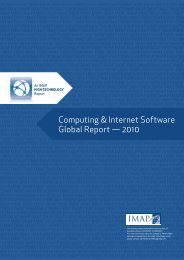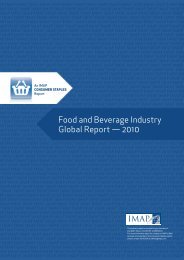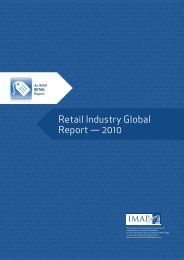The UK marketAlthough North Sea oil production is declining and energyimports now exceed UK production for the first time in 40years, the sector - driven by technological breakthroughs - isstill vibrant and continues to attract considerable interest fromboth home and overseas investors.In particular the market is being strongly driven by the trend oflarger oil groups to reduce their exposure to the North Sea andsell developed assets to companies more willing to extend thelife of declining fields and 'get at' all remaining reserves.According to Oil and Gas UK, a trade body, some 24 billionbarrels of oil still remain to be extracted from the North Seawhile the UK currently exports around £6bn worth of oil and gasa year. Little wonder that the UK government still sees oil, andespecially gas, as a key part of its energy strategy and in early<strong>2013</strong> is set to publish an industrial strategy for the sector.The moves come after a bruising dispute between thegovernment and oil companies in 2011 when the Treasuryraised marginal tax rates for companies operating in the NorthSea to up to 81 per cent in some cases in a £2bn tax raid. Thegovernment later said that income from mature sites would beshielded from the full impact of the supplementary tax charge,a move which Oil and Gas UK says has been instrumental inensuring certain large-scale investments have happened overthe past year to 18 months. The government has also sinceannounced a brownfield tax allowance designed to encourageinvestment in older fields. The tax break shields the first£250m-£500m of income on certain projects from paying a 32per cent supplementary charge tax.Life in North Sea yetA good example of how the life of oilfields is being prolongedis the Forties field which was first discovered in the early 1970sby BP. Production peaked at over 500,000 barrels per day (bpd),but when Texas-based Apache purchased the field from BP adecade ago production had declined to 40,000 to 45,000 bpdand it was expected that the field would close.However since then Apache has raised production by drilling anumber of wells off the Echo platform where drilling costs hadhistorically been high. Apache removed the platform and drilledseveral new wells, adding significantly to production. Apachehas since used seismic technology to identify areas of the fieldthat had not previously been fully drained. Meanwhile in 2011Apache also paid £1.1bn for the oil and gas assets of ExxonMobilin the Beryl field in the North Sea.The continued health of the sector was also evidenced in late2012 when oilfield services company Expro opened a new facilityin Aberdeen to enhance its growing well intervention business.Shale comes to UKSeeing the phenomenal changes to the US market broughtabout by the shale revolution, the UK government is increasinglykeen to see a piece of the action too. In December 2012 thegovernment lifted restrictions on fracking, the method ofextracting gas from shale rock, as it gave the green light todrilling operations at a site in Lancashire. Dozens of more sitescould be licensed in coming years as the government seeks tomake up for declining North Sea supplies.At the time of the lifting of the restrictions the governmentsaid shale gas could contribute significantly to the UK’s energysecurity. It said that companies drilling wells would be subjectto a traffic light system with seismic monitoring to ensure thatif there were tremors above a certain level then drilling would behalted pending investigations.Page 6
Recent notable deals:• In December 2012 the Abu Dhabi National Energy Co (TAQA)announced it was buying a number of BP's North Sea assetsfor £814m. BP said the deal brought its asset divestmentprogramme close to the targeted £23.8bn. The deal involvesBP's interests in the Harding, Maclure and Devenick fields.TAQA said the deal opened up new investment opportunitiessuch as infill drilling on Harding; the ability to unlock significantdiscovered gas resources together with other adjacent fieldowners; and the development of the Morrone field.• In October 2012 Shell was given the go-ahead to develop theFram oil and gas field in the North Sea. Fram is a joint venturebetween Shell UK and Esso Exploration & Production UK.The project is one of the largest currently planned for the UKNorth Sea and will add around two per cent to UK oil and gasproduction. The field is expected to produce an average of35,000 barrels of oil equivalent per day and Shell is working toachieve first production within the next three years.• In October 2012 Canadian oil company Talisman Energy saidit was going ahead with a £1.6bn oil project in the North Sea.The company said the Montrose Area Redevelopment projectwould create or sustain more than 2,000 jobs and lead to theproduction of a further 100 million barrels from the fields whichlie east of Aberdeen. The Montrose platform was first installedin 1976 and is one of the oldest in the North Sea. The project willextend the life of the existing fields by 13 years to 2030.UK <strong>Oilfield</strong> <strong>Equipment</strong> and <strong>Services</strong> groups• In July 2012 Chinese state-controlled oil group Sinopec strucka £940m deal with Talisman Energy to acquire a 49 per centstake in its UK assets. The deal was part of Talisman's strategyto sell off some of its interests in Britain to focus on highergrowthshale gas projects in North America and Southeast Asiawhere it has long-term exploration plans.• In June 2012 Cairn Energy acquired North Sea oil companyNautical Petroleum for £414m. After selling the bulk of itsIndian business to Vedanta Resources, Cairn is attempting tobuild up an oil producing business. In April 2012 it acquired AgoraOil and Gas.• In May 2012 an agreement was struck between EnQuest andKuwait's national oil company to commit £313m to fund theredevelopment of Britain's first producing - but now abandoned- North Sea oilfield. The foreign investment arm of KuwaitPetroleum Company acquired a 35 per cent interest in the Almaand Galia oilfield developments.• In March 2012 BP sold £250m of North Sea gas assetsto Perenco of France as part of its strategy of offloadingageing British fields to concentrate on new projects in UKand Norwegian waters. In May 2011 BP also sold Wytch Farm,the UK's largest onshore oilfield, along with other assets, toPerenco. BP said the divestment represented a "refocusing ofefforts" rather than a withdrawal from the North Sea where itstill plans to develop projects worth £10bn over the next fiveyears.CompanySales: Total £mSales: Oil & Gas £mDescriptionJohn Wood Group Plc3,9163,916Provider of rotating equipment services & solutions to thepower, oil & gas and clean energy markets.Petrofac Limited3,7533,753International provider of facilities solutions to the oil & gasproduction & processing industries.Amec Plc3,2611,696Supplier of consultancy, engineering and project managementservices to the oil and gas, minerals and metals, clean energy,environment and infrastructure markets.Weir Group Plc (The)2,292755.7Engineering group operating within three divisions: Minerals,Oil & Gas and Industrial.KCA Deutag Alpha Limited925925A group engaged as providing drilling and related well andfacilities engineering services.Kentz Corporation Limited885398Provision of construction and engineering services, principallyin the oil services sector.Lamprell Plc742742A group engaged in the provision of specialised refurbishmentand construction services to the oil and gas industry.Cape Plc723362Provides non-mechanical services, principally to plant operatorsin the oil and gas, power generation, chemical, mineral andmining sectors, and E&C contractors.Hunting Plc609609Manufacture and distribution of products that enable theextraction of oil and gas for the world’s leading energycompanies.Expro International Group HoldingsLimited601601A group engaged in the provision of well flow managementservices and products to the upstream oil and gas industry.Page 7








